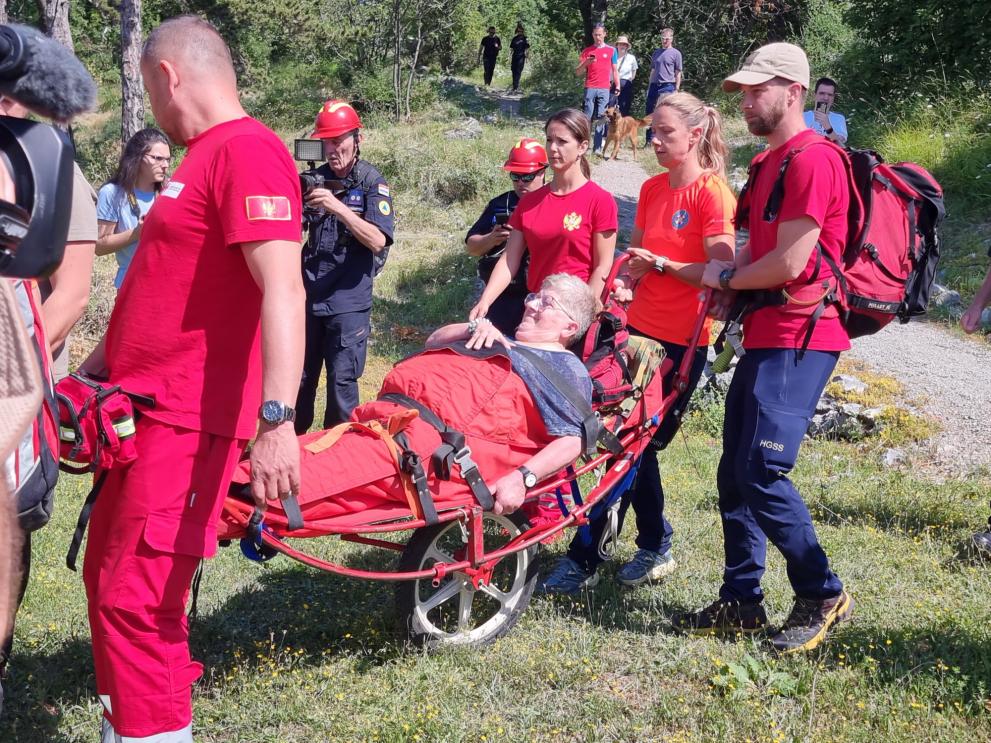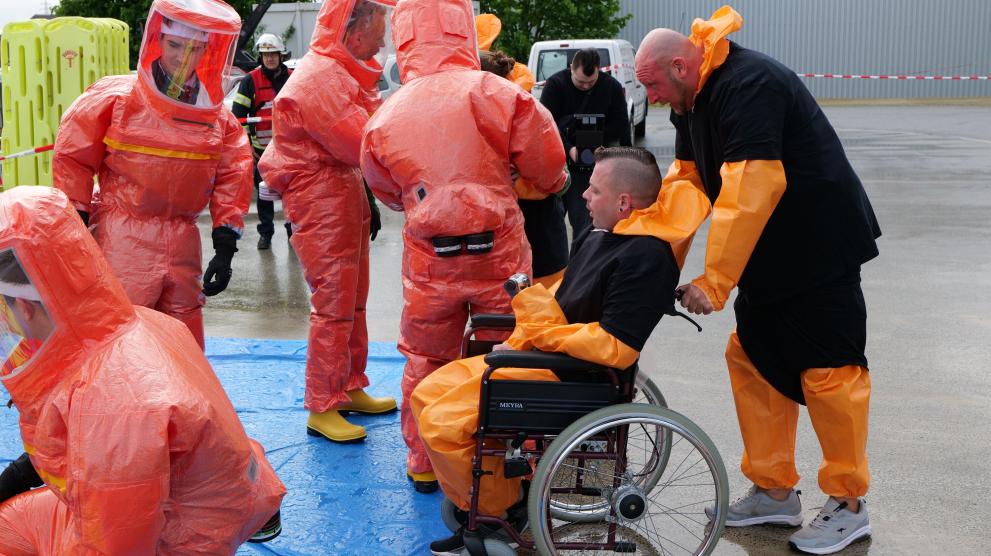Empowering persons with disabilities in disaster risk reduction
On 3 December, the UN’s International Day for Persons with Disabilities calls for action to create a more inclusive and equitable society.
This year’s theme, “Amplifying the leadership of persons with disabilities for an inclusive and sustainable future,” emphasises the importance of empowering persons with disabilities as active participants and leaders in shaping the policies and practices that affect their lives. In the world of civil protection, this message holds particular significance, as persons with disabilities face disproportionately higher risks during disasters and emergencies.
Globally, one in six people, or 16% of the population, lives with disabilities — more than 100 million people in Europe. Disasters and emergencies tend to exacerbate the existing issues confronting persons with disabilities, leading to much higher risks and fatalities. In some cases, persons with disabilities are tragically killed by disasters at a rate that is two to four times higher than the general population (UNDRR).
The theme ‘Amplifying the leadership of persons with disabilities for an inclusive and sustainable future’ is vital for civil protection and emergency management. It emphasises the importance of including persons with disabilities in decision-making, ensuring their needs and perspectives shape preparedness and response strategies. This fosters inclusivity, strengthens resilience, and promotes equitable emergency systems where no one is left behind.
Persons with disabilities are frequently overlooked in emergency planning despite their increased vulnerability. As Berket highlights, “The issues related to the safety, equality, and accessibility of persons with disabilities in emergencies are well perceived by persons with disabilities and their organisations, but less so by emergency services and civil protection organisations. Persons with disabilities are generally under-represented in emergency plans that usually require physical skills and mobility in case of evacuation.
"This lack of representation can result in flawed emergency plans that do not consider the unique needs of vulnerable populations. This gap can lead to evacuation plans and disaster responses that fail to support vulnerable groups effectively."

EU leadership in inclusive disaster preparedness
Recognising these challenges, the EU is working to ensure inclusivity is central to its disaster preparedness and response efforts. The European Accessibility Act (EAA) plays an important role in making everyday products and services easier to use for persons with disabilities across Europe. It sets common standards for areas like transport, banking, e-commerce, and emergency communication, ensuring they are designed to be accessible. Features such as real-time text, audio descriptions, and user-friendly ticketing systems are required under the act, supporting inclusive disaster preparedness and ensuring that no one is excluded during emergencies.
The recent Niinistö Report on resilience and civil protection recommends reinforcing this approach, promoting a whole-of-society framework for disaster preparedness. This report further recommends ensuring inclusivity at every stage—from planning to evaluation. As the report states, “Inclusive disaster preparedness at the community level ensures that the unique needs of persons with disabilities are recognised and addressed.”
This approach relies on shared responsibility by involving governments, civil society, private companies, and communities. Persons with disabilities are no longer seen solely as beneficiaries but as key contributors, with their experiences helping to shape evacuation plans, early warning systems, and training for first responders. Their participation ensures that disaster preparedness is practical and inclusive, addressing diverse needs and challenges. The forthcoming EU Preparedness Strategy will take into account these important recommendations.
Complementing these policy efforts, the EU’s Disaster Goals (DRGs) aim to prioritise including persons with disabilities in DRR planning. These goals seek to create accessible shelters, evacuation plans and recovery programmes, as well as training first responders to appropriately assist persons with disabilities in emergency situations.

Inclusive projects: From policy to practice
Policy frameworks provide the foundation, but it is through implementation that real change happens. Several EU-funded projects have demonstrated how disability inclusion can be integrated into disaster preparedness and response.
SEE ME: Safe and Equal in Emergencies
The SEE ME 2 project, coordinated by Marijana Berket, aims to ensure that persons with disabilities are not only protected during emergencies but are also actively involved in disaster preparedness. The project includes persons with disabilities in planning, training, and response activities, recognising their valuable contributions. As Berket explains, “Persons with disabilities are key to shaping their own safety. They bring valuable insights that improve disaster preparedness for everyone.”
A major focus of the project is closing gaps in emergency plans, which often overlook the specific needs of persons with disabilities. SEE ME 2 has created clear recommendations for rescue and protection strategies tailored to various types of disabilities. These guidelines help first responders adapt their lifesaving efforts to meet the needs of individuals with physical, sensory, intellectual, and mental impairments, ensuring a more inclusive and effective response. In addition, GIS technology (Geographic Information System technology, is a tool that captures, analyses, and visualises spatial and geographic data, enabling precise location tracking and decision-making during emergencies) and has also been integrated to assist in locating and rescuing persons with disabilities during emergencies, which allows for faster and more accurate response.
Through training sessions and community engagement, PwDs have gained practical knowledge and skills, enabling them to take a more active role in their own safety. This inclusion not only fosters a sense of empowerment but also promotes equal participation in emergency management processes, ensuring that their rights and perspectives are integrated into broader preparedness and response frameworks.
SEE ME’s mission also centres on public awareness and self-empowerment. The project provides persons with disabilities with useful knowledge through training sessions and educational materials, which serve to increase their resilience. This also includes efforts to raise awareness among local authorities and civil protection teams and to encourage them to include persons with disabilities in the planning process. As Berket points out, “When emergency plans overlook the specific needs of vulnerable groups, the result can be deficient assistance or even worsening the impact of disasters rather than reducing it.”
eNOTICE-2: Inclusive CBRN preparedness
The eNOTICE-2 project, coordinated by Dr Olga Vybornova, addresses the unique challenges of Chemical, Biological, Radiological, and Nuclear (CBRN) emergencies for persons with disabilities. It focuses on procedures for decontaminating assistive devices like wheelchairs and hearing aids, ensuring they remain usable after a crisis.
The project has developed clear guidelines to safely decontaminate assistive devices and updated training for first responders, integrating feedback from persons with disabilities and disability organisations.
A key strength of eNOTICE-2 is its collaborative approach. The project carried out over 30 interviews with persons with disabilities, caregivers, and emergency responders to gather input that is invaluable to design educational materials that are clear and practical. “Involving persons with disabilities in creating these materials ensures the guidelines are both realistic and meaningful" Vybornova explains.
Assistive devices are not just tools; they provide security and stability for many people with disabilities. Not taking them into account during emergencies can severely impact the individual’s safety and independence.
Looking ahead, eNOTICE-2 aims to test and validate its procedures through exercises, ensuring they meet high standards of safety, efficiency, and usability. “By implementing these recommendations, we ensure that first responders are better prepared, assistive devices remain usable, and persons with disabilities are informed and supported during emergencies.” Vybornova concludes.
RescEU shelter project: Inclusive solutions for vulnerable groups
The rescEU shelter project, coordinated by the European Commission and Member States, focuses on creating emergency shelters that are accessible and inclusive for all, including persons with disabilities. This collaborative effort aims to ensure that emergency response systems consider the specific needs of vulnerable groups, avoiding barriers that could make crises even harder to navigate.
The shelters are designed with accessibility in mind. Croatia, for example, is developing containers and tents with wheelchair ramps, wider doors, and specially adapted beds to make the shelters more usable for persons with disabilities. Poland is introducing innovative Near Field Communication (NFC) stickers that provide audio descriptions, enabling individuals with visual impairments to access information about shelter services independently. Meanwhile, Sweden is including mobility-friendly facilities, tailored hygiene kits, and ramps to ensure the shelters are practical for a wide range of needs.
By integrating rights-based approaches, the project ensures that these shelters respect the dignity and rights of all individuals. Member States regularly share lessons learned and best practices from deployments, fostering continuous improvement and innovation.
An inclusive future starts today
Projects like these, which prioritise disability inclusion in civil protection, can serve as a powerful example of what can be achieved through collaboration, innovation, and a shared vision for resilience. From policy frameworks like the Niinistö Report to projects such as SEE ME and eNOTICE-2, Europe is taking concrete steps to ensure that persons with disabilities are not only protected but also empowered to lead.
As the world observes the International Day for Persons with Disabilities, it is a reminder that inclusion is not just a goal but a shared responsibility. Empowering persons with disabilities to take leadership roles and ensuring their active participation in disaster preparedness and response is essential for a resilient future. In the words of Commissioner Lahbib during her recent European Parliament hearing as Commissioner-designate, “Disability inclusion is not just about removing barriers—it’s about creating opportunities for leadership and ensuring every voice is heard in building a better, more resilient society.